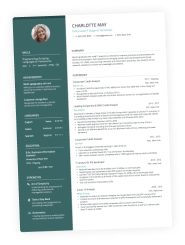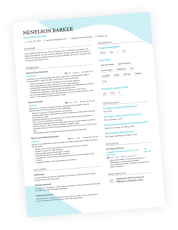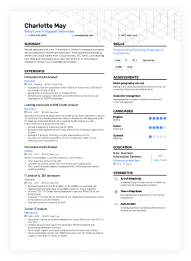Writing your CV might seem like an easy task at first – you just list all your relevant information, and you are ready to go.
However, that’s far away from the truth.
There are plenty of factors you need to take into account to make your CV stand out and grab the recruiter’s attention.
In this article, we are going to help you get the best out of your CV by exploring the following questions:
- What section you should have on your CV?
- What order should you put your CV sections in?
- What goes where – the difference between sections in your CV
If you want to take the extra step, and make your CV even better, you should definitely check out our CV Builder.
But if you are ready to get a better understanding of the different sections in your CV, let’s dive in.
Is your resume good enough?
Drop your CV here or choose a file. PDF & DOCX only. Max 2MB file size.
What sections you should have on your CV?
Every CV consists of the same basics in the face of the most essential sections that would showcase you in the best light possible in front of the recruiter.
The sections that are an absolute must in your CV are:
- Contact information
- CV summary / objective
- Work experience
- Education
- Skills
However, your CV can really benefit from some extra information, as long as it is relevant to the position you are applying for.
Some sections you can consider adding in your CV, if you have anything to show in them, are:
- Certifications
- Language skills
- Additional training and courses
- Publications
- Awards
- Projects
And if you still have some blank space in your CV, you can consider adding in some less relevant sections that would show off your personality to the recruiter.
Such sections are:
- Volunteer work
- Hobbies and interests
- Extracurricular Activities
- Blogging and influencing
What order should you put your CV sections in?
Now that you know all the sections you need in your CV, there is one detail we need to explore before diving into the specifics of each section.
It is extremely important to order your CV sections just right, as that’s how you present yourself to the recruiter.
You might think that there is a universal way to do so, but the truth is – it all depends on what you want to draw the most attention to.
We are going to explore the three most common situations and what order you should use for each in your CV.
If you are an experience professional looking for their next job opportunity following your career path:
- Contact information
- CV summary / objective
- Work experience
- Certifications (Optional)
- Education
- Skills
- Additional sections
However, if you are fresh out of college and have little or no work experience yet, you would want to use a slightly different order for your CV sections:
- Contact information
- CV summary / objective
- Education
- Work experience (make sure you include internships and volunteer work here as well)
- Skills
- Additional sections
The last most common scenario we would like to have a look at is when you have taken on a career change. In that case, follow this order for your CV sections:
- Contact information
- CV summary / objective
- Relevant work experience
- Additional work experience (Optional)
- Education
- Skills
- Additional sections
Understanding the different sections in your CV
Now that you know what are the most essential sections in your CV, and what is the right order for them depending on your situation, it is time to dig deeper in what you should include in them.
Contact information
The first essential section of your CV is your contact information.
As a minimum, you should list your:
- Full name
- Phone number
- Email address
When listing your email address, make sure you use a professional one, as you wouldn’t want to look silly.
The best way to go is to use your names in your email address and host it in GMail, or another well-known email provider. A format like “firstname.lastname@gmail.com” is the most common and well perceived by recruiters.
However, you can also add in much more contact information about yourself.
If you think it would present you in a good light, you can also list your:
- LinkedIn profile
- City and/or country you live in
- Professional website
- Other social media
What you need to keep in mind is that you would want to look professional in the eyes of the recruiter, so don’t add any social media profiles that would make you look anything else.
CV summary / CV objective
Right below your contact information should come the first essential information that the recruiter would read.
It can be in a form of a CV summary or CV objective, but either way, it should catch the recruiter’s attention.
It is crucial to write a good statement there that is also relevant to the position you are applying for, as that’s the point where the recruiter would decide whether to keep reading your CV.
You might ask yourself what is the difference between a CV summary and a CV objective, so let’s have a quick look at that:
- A CV summary is a 3-4 sentence summary of your work history. It should include:
- Professional title
- Years of experience
- Top 1–2 achievements
- Most relevant skills
- A CV objective is a 3-4 sentence summary of your professional goals and educational background. It should include:
- Your current situation
- The position you are applying for
- Relevant educational background
- Relevant skills
Work experience
In most cases, the most important part of your CV is your previous work experience.
Recruiters are highly interested in that, as it shows that you can get the job done, as you have done before.
To write your work experience section correctly, you first need to remember that you should add entries in reverse-chronological order.
And as for the entries themselves, make sure each consist of:
- Position name
- Company name
- Dates of employment
- Bullet points with your best achievements and responsibilities
If possible, make sure you fill your bullet list mainly with achievements, as they are much more impressive in the eyes of the recruiters.
Also, what you would like to omit in your work experience section are any:
- Short-term jobs (unless you have very little work experience)
- Explanations of employment gaps
- Tables, images, or charts
Education
Another essential part of your CV that you should not omit is your Education.
Depending on your work experience, it can be more or less important to make your CV strong.
In case you are a recent graduate, you would like to include more details and academic accomplishments.
But if you already have some extensive work experience behind you, simply stating the institutions and some basic information about your education would be enough.
Check out the information you can add in each of your education entries, and decide how much you would like to focus on your education. Each entry can consist of:
- Degree and speciality
- Name of the academic institution
- Dates attended
- Grade (if you include it, make sure it is high)
- Honours
- Academic achievements
- Courses taken
Skills
The last essential section of your CV is the one used to describe all your soft and hard skills.
What you would want to do here is make a list of all the skills you possess, and decide which ones are most relevant to the position you are applying for.
Also, make sure you have a realistic view on your level of proficiency for each skill, as you would want to share that information in your CV, and you would want it to be true.
When deciding between the number of soft and hard skills to include in your CV, you should keep the balance between the two. However, recruiters are more likely to search for hard skills on your documents, so make sure there is at least a small prevail on those.
Takeaways
We are all done, now you understand the different sections in your CV.
You now know which sections are essential on your CV, and which ones you can skip.
You also know how to order your CV depending on your current situation and the effect you would like to have on the recruiter with your CV.
Let’s also go through all the essential sections, and what we learnt about them:
- Contact information – it is essential to add at least your name, phone number, and a professional-looking email address, so that the recruiter can reach out to you
- CV summary / CV objective – it depends on your needs which one you would pick, but either way it needs to be attention-catching, as that is the first thing the recruiter would read on your CV
- Work experience – this is arguably the most important section of your CV, and you need to make it as impressive as possible with all your past work-related accomplishments
- Education – depending on your past work experience, this section can be less or more important, but it is still essential to list your educational background
- Skills – last but not least, you need to list your most relevant soft and hard skills for the position you are applying for. Make sure you keep the balance between the two, but also give a little prevail to the hard skills, as these are what the recruiters would be looking for
Now that you know all that, you are ready to make your CV the best it can be.



